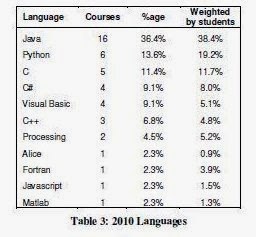Content:
(1) What is your essential question and answers? What is your best answer and why?
My essential question is "What is the best programming language to use when developing mobile applications?" My answers include Java, Objective-C, and HTML5/CSS. The best programming language to use when developing mobile applications is Java because it is the standard language for developing Android applications. It also uses a object-oriented programming paradigm, and makes it essential to learn in the market with other languages as well. With over 1.1 million electronic units such as set boxes, computers, and phones, its integrity in the market is not difficult to see.
(2) What process did you take to arrive at this answer?
It took me a while to arrive at this answer since it was difficult to actually see which language had the most impact on the market. I had started to do research on how to use Java to start developing mobile apps through Android Application Development All-in-One for Dummies by Barry Burd. He explained some history of Java and how Google obtained Android, which became a part of how Java was the main language for the platform. Comparing Objective-C and HTML5 to Java is difficult as Objective-C is very similar but more dynamic in execution as according to Neal Goldstein in iPhone Application Development All-in-One for Dummies but Java has a better outlook with their free-to-use platform and open-source development kit.
HTML5 may be accessible as a web-based language and standard for the Internet in terms of webpages, making it more accessible on all platforms(Building Android Apps with HTML, CSS, and Javascript, Jepson). However, it is only limited to the web use and can not be saved completely on the device. Independent Components 1 & 2 assisted in my endeavor to arrive at this answer. After working with all three languages and learning how they can be applied(Java with a simple Application, Objective-C and HTML5 basic courses). I arrived at the answer after the research, comparisons, and feeling them out myself.
(3) What problems did you face?
How did you resolve them?
Some problems that I faced during the project included finding a mentorship, finding valid research for each answer, and discovering each aspect that makes the language different from one another. For my mentorship, I was not able to find a top-of-the-line mentorship that completely focused on developing applications due to the confidentiality. Instead, Cal Poly's Student Affairs Information & Technology Services were able to provide me with a mentorship to gain some experience with languages like XML.
Valid research was difficult at first as finding sources that directly deal with languages is vague in itself. However, looking through databases and Cal Poly's sources helped me find them. Going through tutorial books on each language was a good way to find research as well. This also applies to each aspect of the answers. All are similar in terms of significance but each attribute of the languages that helped me decide were found in multiple programming books, a couple of studies and articles.
(4) What are the two most significant sources you used to
answer your essential question and why?
Burd, Barry. Android Application Development All-In-One for Dummies. Hoboken: John Wiley & Sons, Inc., 2012. Book
Cooper, Graham, Raina Mason & Michael de Raadt. “Trends in Introductory Programming Courses in Australian Universities – Languages, Environments and Pedagogy” Proceedings of the Fourteenth Australasian Computing Education Conference 123 (2012): 33-42. Print.
Both sources were significant sources in answering my essential question. Android Application Development All-in-One for Dummies by Barry Burd provided the framework as to how Java stands out in terms of mobile development and why it plays a significant part in the Android Market, with its iterations, open-source, and object-oriented concepts.
"Trends in Introductory Programming Courses" supported my answer in a significant way as Java is considered to be a language taught at Universities in Australia, holding the top spot with 38.4% as according to students. It also provided a study of how students decide on a programming language to learn in general, with 3 reasons support it.
Be prepared with evidence and specific examples to support any
response. It is also significant to cite
sources as you explain.
.jpg)


.jpg)







